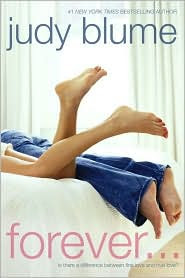 Later, Grandma said, "He's a nice boy, Kath." "I know." "Intelligent." "Uh huh." "Attractive, too." "I agree." "Just be careful...that's my only advice." "Of what?' "Pregnancy.""Grandma!" "And venereal disease." "Does it embarrass you to talk about it?"
Later, Grandma said, "He's a nice boy, Kath." "I know." "Intelligent." "Uh huh." "Attractive, too." "I agree." "Just be careful...that's my only advice." "Of what?' "Pregnancy.""Grandma!" "And venereal disease." "Does it embarrass you to talk about it?"Judy Blume's
Forever... examines how Katherine Danziger decides whether to have sex with her first long term boyfriend, Michael Wagner. Katherine and Michael are seniors and they have a caring, committed, mutually respectful relationship. Katherine is lucky enough to have a family, and particularly a grandmother, who want the best for her and are willing to talk openly about taking her relationship to a sexual level. Her grandmother is very active in Planned Parenthood and the National Organization of Women and she wants to make sure that Katherine will take care of her health and her future.
When
Forever... was written in the mid-1970s, it caused quite a stir because the teens here talk openly and honestly about sex (although there are a few mutual orgasms occurring that may not necessarily reflect the reality of sex for those new to the act). It almost seems like a throwback now and it is hard to believe the book caused such a stir.
A warning though, there are scenes of sexuality (although they are treated in a responsible way) and not all parents may approve because of these situations. They should, because, honestly, this is the frank talk they must have with their kids about how to protect themselves.
The book does not try to say this is right or wrong for everyone but rather a personal decision between two people. Blume also takes care not to trivialize the love you are capable of having at 17. It doesn't necessarily work out for everyone but that doesn't mean that it isn't just as overwhelming or an important, epic, part of our lives.
Forever... should be recommended reading for 14 to 16 year old women
and men because it demonstrates not only how to make an important decision in a mature and responsible way but it does it without reading like a brochure from a sexual health centre or a poorly acted after school movie. The moral doesn't hit you over the head because Blume is a skilled enough writer that the characters come to life for her readers, who will agonize over where Michael and Katherine's relationship will take them once they graduate.
The details: Blume, Judy.
Forever. New York: Simon Pulse, 1975.















